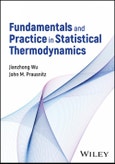Thermodynamics is a discipline which straddles the fields of chemistry, physics, and engineering, and has long been a mainstay of undergraduate and graduate curricula. Conventional thermodynamics courses, however, often ignore modern developments in statistical mechanics, such as molecular simulation methods, cooperative phenomena, phase transitions, universality, as well as liquid-state and polymer theories, despite their close relevance to both fundamental research and engineering practice. Fundamentals and Practice in Statistical Thermodynamics fills this gap with an essential book that applies up-to-date statistical-mechanical techniques to address the most crucial thermodynamics problems found in chemical and materials systems. It is ideally suited to introduce a new generation of researchers and molecular engineers to modern thermodynamic topics with numerous cutting-edge applications.
From Fundamentals and Practice in Statistical Thermodynamics readers will also find: - An introduction to statistical-mechanical methods including molecular dynamics simulation, Monte Carlo simulation, as well as the molecular theories of phase transitions, classical fluids, electrolyte solutions, polymeric materials, and more - Illustrative examples and exercise problems with solutions to facilitate student understanding- Supplementary online materials covering the basics of quantum mechanics, density functional theory, variational principles of classical mechanics, intermolecular interactions, and many more subjects
Fundamentals and Practice in Statistical Thermodynamics is ideal for graduate and advanced undergraduate students in chemical engineering, biomolecular engineering, environmental engineering, materials science and engineering, and all related scientific subfields of physics and chemistry.
Table of Contents
Preface xix
About the Companion Website xxi
1 Microscopic Origin of Thermodynamics 1
1.1 Microscopic Constituents of Thermodynamic Systems 1
1.2 Thermodynamic Relations 5
1.3 Microscopic Uncertainty, Ensemble Average, and Ergodicity 10
1.4 Entropy and Information 15
1.5 Ab initio Thermodynamics 21
1.6 Statistical-Thermodynamic Models 24
1.7 Additivity and Relativity in Thermodynamics 29
Chapter Summary 32
Further Readings 33
Problems 33
2 Statistical Ensembles and MD Simulation 39
2.1 Microcanonical Ensemble 39
2.2 Basics of MD Simulation 45
2.3 Canonical Ensemble 50
2.4 Thermostat Methods 54
2.5 The Langevin Dynamics 59
2.6 Fluctuation-Dissipation Theorem 64
2.7 Isobaric-Isothermal Ensemble 68
2.8 Isobaric Molecular Dynamics 73
2.9 Grand Canonical Ensemble 76
2.10 Transformation Between Ensembles 80
2.11 Generalized Ensembles 85
Chapter Summary 89
Further Readings 93
Problems 94
3 Ideal Gases and Single-Molecule Thermodynamics 105
3.1 Noninteracting Molecular Systems 105
3.2 Monatomic Ideal Gases 108
3.3 Diatomic Molecules 116
3.4 Polyatomic Molecules 123
3.5 Chemical Equilibrium in Ideal-Gas Mixtures 128
3.6 Thermodynamics of Gas Adsorption 132
3.7 Thermodynamics of Gas Hydrates 139
3.8 Ideal Polymer Chains 145
3.9 Gaussian Chains 152
3.10 Statistics of Copolymer Chains 157
3.11 Semi-Flexible Chains 159
3.12 Random-Walk Models 164
Chapter Summary 171
Further Readings 172
Problems 173
4 Thermodynamics of Photons, Electrons, and Phonons 187
4.1 Quantum Particles 187
4.2 Quantum Statistics 192
4.3 Thermodynamics of Light 197
4.4 Radiation and Solar Energy Conversion 203
4.5 The Free-Electron Model of Metals 210
Chapter Summary 228
Further Readings 229
Problems 229
5 Cooperative Phenomena and Phase Transitions 241
5.1 Spins and Ferromagnetism 242
5.2 The Ising Chain Model 243
5.3 Ionization of Weak Polyelectrolytes 251
5.4 The Zimm-Bragg Model of Helix-Coil Transition 257
5.5 Two-Dimensional Ising Model 262
5.6 Mean-Field Methods 268
5.7 Lattice Models 274
5.8 Order Parameters and Phase Transitions 283
5.9 The Landau Theory of Phase Transitions 288
5.10 Microemulsion and Liquid Crystals 297
5.11 Critical Phenomena and Universality 301
5.12 Renormalization Group (RG) Theory 306
5.13 Generalized Ising Models 316
Chapter Summary 320
Further Readings 325
Problems 325
6 Monte Carlo Simulation 337
6.1 Importance Sampling 338
6.2 Monte Carlo Sampling 343
6.3 The Metropolis-Hastings Algorithm 348
6.4 Monte Carlo Simulation for an Ising Chain 351
6.5 Simulation Size 354
6.6 mc Simulation for Simple Fluids 360
6.7 Biased MC Sampling Methods 365
6.8 Free-Energy Calculation Methods 372
6.9 Simulation of Crystalline Solids 377
6.10 Monte Carlo Simulation of Fluid Phase Equilibria 385
6.11 Histogram Reweighting Analysis 393
6.12 Enhanced Sampling Methods 404
Chapter Summary 417
Further Readings 421
Problems 421
7 Simple Fluids and Colloidal Dispersions 429
7.1 Microstates in the Phase Space 429
7.2 Radial Distribution Function and Structure Factor 434
7.3 Structure-Property Relations 441
7.4 Integral Equation Theories 448
7.5 Hard-Sphere Model 455
7.6 The Sticky Hard-Sphere Model of Colloids and Globular Proteins 463
7.7 The van der Waals Theory 467
7.8 The Cell Model for Colloidal Crystals 474
7.9 Order Through Entropy 478
7.10 Colloidal Phase Diagrams and Protein Crystallization 481
7.11 Perturbation Theories 485
7.12 Critical Behavior of Fluid-Fluid Transition 497
7.13 Molecular Theory of Critical Phenomena 503
Chapter Summary 511
Further Readings 521
Problems 521
8 Polymer Solutions, Blends, and Complex Fluids 537
8.1 The Flory-Huggins Theory 537
8.2 Phase Behavior of Polymer Solutions and Blends 545
8.3 Statistical Mechanics of Polymeric Fluids 553
8.4 Equations of State for Hard-Sphere Chains 563
8.5 Statistical Associating Fluid Theory (SAFT) 578
8.6 Random-Phase Approximation 586
8.7 Continuous Gaussian Chains Model and the Polymer Field Theory 591
Chapter Summary 598
Further Readings 618
Problems 618
9 Solvation, Electrolytes, and Electric Double Layer 635
9.1 The McMillan-Mayer Theory 635
9.2 Phenomenological Solvation Models 645
9.3 Solvent-Mediated Potentials and Colloidal Forces 654
9.4 Electrostatics in Dilute Electrolytes 664
9.5 Extended Debye-Hückel Models 671
9.6 Integral-Equation Theories for Ionic Systems 679
9.7 Statistical Behavior of Polyelectrolyte Chains 691
9.8 The Cell Model and Counterion-Condensation Theory 697
9.9 Liquid-State Theories of Polyelectrolyte Solutions 704
9.10 Electric Double Layer (EDL) 710
Chapter Summary 718
Further Readings 720
Problems 720
Index 735








